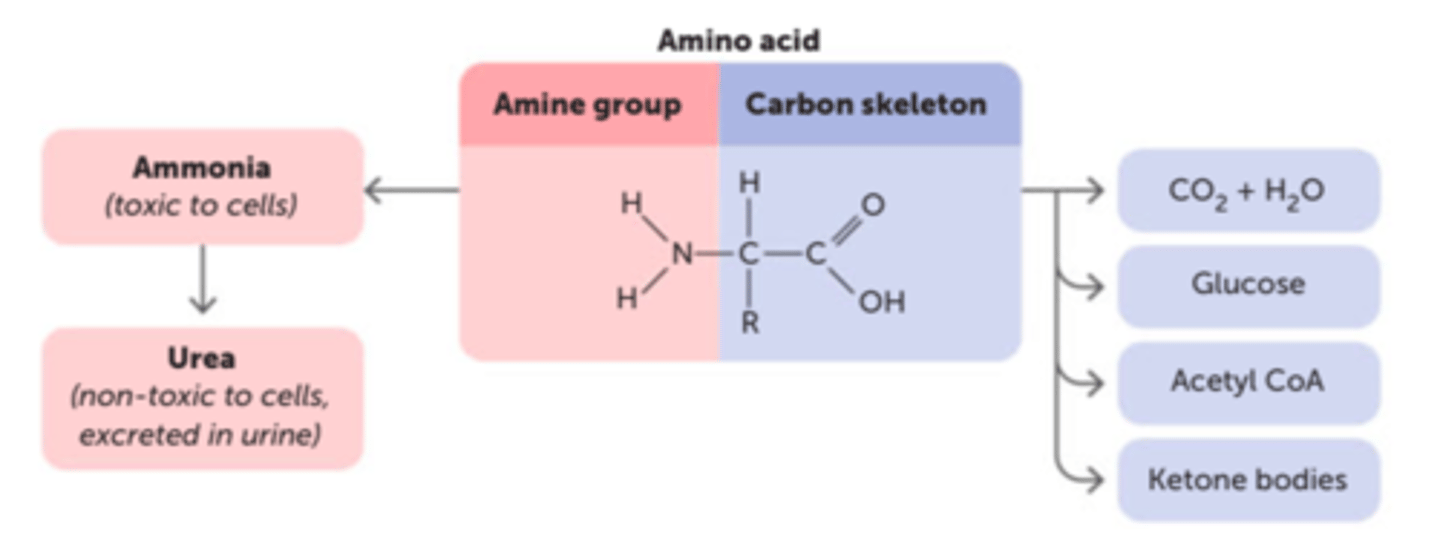Chapter 7: The Excretory System Removes Waste Products
1/33
There's no tags or description
Looks like no tags are added yet.
Name | Mastery | Learn | Test | Matching | Spaced |
|---|
No study sessions yet.
34 Terms
excretion
the removal of metabolic wastes from the body
why is excretion necessary?
wastes may become toxic, leading to loss of homeostasis, decline in cell functionality or death of the cell
deanimation
the removal of the amino group from an amino acid molecule, with the aid of enzymes. this occurs when there are excess amounts of proteins, or if carbohydrates and fats have run out

word equation of deanimation
amino acid + oxygen ---> carbon skeleton (carbohydrate) + ammonia
carbon skeleton
the left over structure after deamination which is turned into carbohydrates (glucose) for energy
role of lungs in excretion
remove carbon dioxide
role of liver in excretion
-enzymes in the liver help deamination occur, where the removed amino group is converted to ammonia, then urea which is eliminated in urine
-the liver detoxifies alcohol
-deactivates hormones and transforms them into a form that can be excreted by the kidneys
-breaks down haemoglobin from dead red blood cells to produce bile pigments
word equation of the production of urea
energy + carbon dioxide + ammonia --> urea + water
where is urea produced?
in the liver
role of skin in excretion
contains sweat glands which secrete sweat, which is water containing dissolved sodium chloride, lactic acid and urea
role of kidneys in excretion
maintains the constant concentration of materials in the body's fluids
role of the alimentary canal in excretion
passes out bile pigments, which are the breakdown products of haemoglobin
nephron
functional unit of the kidney which remove wastes from blood and regulate blood composition
glomerular filtration
selective reabsorption
the absorption of certain selected molecules, including water and solutes, back into blood circulation, from the fluid in the nephron tubule.
how is reabsorption in the kidneys maximised?
-long length of kidney tubule/Loop of Henle, increases surface area
-microvilli lining renal tubule
-millions of nephron in each kidney
tubular secretion
-selectively adds substances (drugs, creatinine, hydrogen ions) from the blood to the filtrate in the renal tubules and collecting ducts
-this is in order to maintain the bloods pH levels, as the blood should not be acidic
-it also maintains the urine's pH level
how does the structure of the kidney maximise formation of urine?
-there are only two cells for the filtrate to pass through, one from the walls of the glomerulus, and one from the wall of the Bowman's capsule
-continual flow of large volumes of blood through each kidney maintains concentration gradient
-the efferent arteriole has a smaller diameter than the afferent arteriole, increasing blood pressure and making more blood be filtered
-each tubule has a large surface area due to there being long, convoluted sections of the renal tubule
-each kidney has over a million nephron, increasing surface area
composition of urine
water, urea, ions, uric acid, creatinine
renal corpuscle
glomerulus and bowman's capsule
glomerulus
a knot of capillaries surrounded by the Bowman's capsule in the nephron, serving as the site of filtration
what does the filtrate consist of?
everything except for red and white blood cells as they are too large to fit across the semipermeable membrane
-water, salts, amino acids, glucose, ions, hormones, fatty acids, urea, uric acid
peritubular capillaries
network of capillaries surrounding the nephron allowing reabsorption of desirable molecules including water, amino acids, glucose, ions and some urea (in order to maintain a concentration gradient)
collecting duct
tube that collects filtrate from multiple nephrons and carries it to the renal pelvis, then ureter
renal artery
blood vessel that carries blood to the kidney
renal vein
blood vessel that carries blood away from the kidney towards the heart
where does glomerular filtration occur?
renal corpuscle
where does selective reabsorption occur?
proximal convoluted tubule, loop of henle, distal convoluted tubule, collecting duct
where does tubular secretion occur?
distal convoluted tubule
Loop of Henle
loop shaped section of the nephron tubule that conserves water and minimizes the volume of urine
descending limb
the descending part of the Loop of Henle which is permeable to water, so water is reabsorbed
ascending limb
the ascending part of the Loop of Henle which is impermeable to water, and is where ions are reabsorbed
what makes the colour of urine?
-bile pigments
-concentration of solutes
what does high concentration of glucose in urine indicate?
diabetes or kidney damage